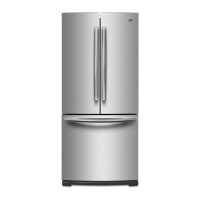17
Noise
The motor seems to run
too much
High efficiency compressor and fans This is normal. Larger, more efficient refrigerators run longer.
The room or outdoor temperature is
hot
It is normal for the refrigerator to work longer under these
conditions. For optimum performance, place the refrigerator
in an indoor, temperature controlled environment. See
“Location Requirements.”
A large amount of warm food has
been recently added
Warm food will cause the refrigerator to run longer until the
air cools to the desired temperature.
The door(s) are opened too frequently
or for too long
Warm air entering the refrigerator causes it to run more.
Open the door less often.
The refrigerator door or freezer drawer
is ajar
Make sure the refrigerator is level. See “Door Closing and
Door Alignment.” Keep food and containers from blocking
the door.
The refrigerator control is set too cold Adjust the refrigerator control to a less cold setting until the
refrigerator temperature is as desired. See “Using the
Controls.”
The door or drawer gasket is dirty,
worn or cracked
Clean or change the gasket. Leaks in the door seal will cause
the refrigerator to run longer in order to maintain desired
temperatures.
The lights do not work A light bulb is loose in the socket or
burned out
Tighten or replace the light bulb. See “Changing the Light
Bulbs.”
PROBLEM POSSIBLE CAUSES SOLUTIONS
The refrigerator seems
noisy
Below are listed some normal
sounds with explanations.
The compressor in your new refrigerator regulates
temperature more efficiently while using less energy, and
operates quietly. Due to the reduction in operating noise you
may notice more intermittent noises.
Sound of the compressor
running longer than expected
High efficiency compressor and fans This is normal. Larger, more efficient
refrigerators run longer.
Pulsating/Whirring Fans/compressor adjusting to optimize performance during
normal compressor operation
This is normal.
Popping Contraction/expansion of inside walls, especially during
initial cool-down
This is normal.
Hissing/Dripping Flow of refrigerant, or flow of oil in the compressor This is normal.
Vibration The refrigerator may not be steady Adjust the leveling screws and lower
the leveling foot firmly against the
floor. See “Door Closing and Door
Alignment.”
Rattling/Banging Movement of the water lines against the refrigerator cabinet,
or of items placed on top of the refrigerator cabinet
Move excess water line away from the
refrigerator cabinet or fasten excess
tubing to the cabinet. See
“Connecting the Water,” or remove
items from the top of the refrigerator.
Sizzling Water dripping on the heater during defrost cycle This is normal.
Water running/Gurgling May be heard when ice melts during the defrost cycle and
water runs into the drain pan
This is normal.
Buzzing Heard when the water valve opens to fill the ice maker This is normal.
Creaking/Cracking May be heard as ice is being ejected from the ice maker
mold
This is normal.
Ker-plunk May be heard when the ice falls into the ice storage bin This is normal.
PROBLEM POSSIBLE CAUSES SOLUTIONS

